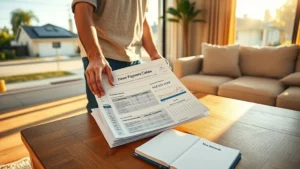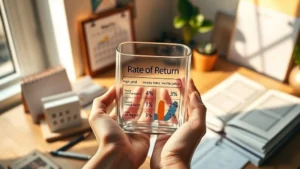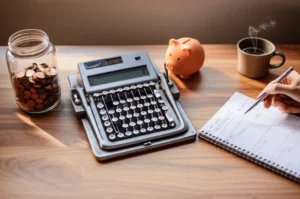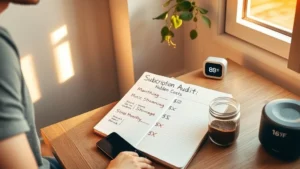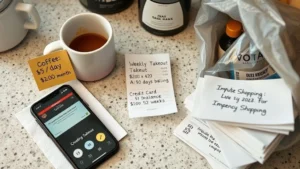Messy Money Moments
Ever woken up in a cold sweat, anxiety gnawing at your stomach because you heard a weird clunk from your car yesterday? Or maybe you had that sinking feeling opening a bill you weren’t expecting… Been there, friend. Honestly, it’s those tiny, gnawing moments of stress—the “wait, do I even have enough for this?”—that finally got me thinking about an actual emergency fund. Not just a random $500 somewhere, but a real, grown-up $30,000 emergency fund. And it’s made a way bigger difference than I thought possible.
Here’s the thing: I used to roll my eyes at articles that started with “build your safety net today!” I figured they were for people with way fancier jobs or more willpower than me. Turns out, it’s not about being perfect—it’s about outsmarting those heart-sinking surprises. So, let’s break it all down. No lectures or boring jargon. Just a warm cup of coffee and some real talk about money, mess-ups, and how to build a safety cushion so you finally sleep easier.
$30k—Too Much or Just Right?
What’s In a Number?
Here’s the question I hear all the time (and ask myself, to be honest): Isn’t $30,000 in an emergency fund overkill? I mean… who has that just chilling in their account? Turns out, there’s actually a method to this madness. If your household spends about $5,000 a month—which is surprisingly normal for anybody renting, raising kids, living in a city, or, heck, just existing these days—then six months’ worth is $30,000. Experts from financial sites like Stash and Vanguard say that’s the gold standard for protecting yourself against the big stuff, like losing your job or getting slammed by hospital bills (research on spending habits).
But honestly? The best number is whatever helps you sleep at night. I saw this epic Reddit thread where people debated whether $30k was “too safe”—and the most upvoted answer? “Enough to let you sleep soundly at night.” For some, that’s $5k. For others, it’s a year’s worth of salary. No shame, just self-awareness.
When Does a Big Fund Matter?
Quick story: Last year, my buddy lost his tech job unexpectedly. He’s a “worst-case-scenario” planner, so he’d saved a bit aggressively—just in case, you know? That $30,000 emergency fund meant he didn’t have to panic-apply for jobs or reach for the credit cards. He took his time, found work that actually paid what he was worth, and—here’s the kicker—kept his sanity.
Compare Your Cushion
| Your Situation | Monthly Expenses | Target Fund (3–6 Months) |
|---|---|---|
| Single, low cost city | $2,000 | $6,000–$12,000 |
| Family, high cost area | $5,000 | $15,000–$30,000 |
| Freelancer, variable | $4,000 | $12,000–$30,000+ |
See? Plug in your real numbers. If $30,000 sounds wild, use this as a starting point. You can always adjust later—and no, nobody gets a plaque for “most saved.”
Emergency Fund vs. Savings? Let’s Clear This Up
Wait, So There’s a Difference?
I’ll be honest, for years my “emergency fund” and savings were basically the same sad pile—half-aimed at holiday gifts, half-forgotten about until my tires needed replacing. Is that you, too? You’re not alone.
Here’s how a friend explained it (with extra hand gestures for emphasis): an emergency fund is your “oh crap” stash—think medical bills, job loss, emergency plane ticket. Planned spending, like a vacation or new laptop, belongs in regular savings. Mixing them is like using your milk money for new shoes—tempting, but regrettable. This article on Emergency Fund vs. Savings Account nails it, and if you want a deeper dive into the details, check out how is an emergency fund similar to and different from a savings fund?.
Why Not Just a Checking Account?
Here’s a confession: for a long time I kept “emergency money” in my checking account. But, you know what? It disappeared… one impulse Target run at a time. (No judgment. I still love their dollar aisle.) Turns out, there’s real wisdom in keeping your emergency fund “out of sight, out of mind” but not too out of reach. There’s even science on this: the harder your money is to “accidentally” spend, the longer it’ll last. That’s why so many articles recommend a separate high-yield savings account, not checking. If you’ve ever wondered why shouldn’t you keep your emergency fund money in your checking account?, now you know—it’s about protecting yourself from… well, yourself.
Building $30,000—Slow and Steady (and Sometimes Messy)
How Do I Start Without Freaking Out?
This is the part where most people (including me) freeze up. Because who actually has $30k lying around, right? Take a deep breath. You do not have to save it all at once. You just need a plan.
Step one: figure out the real number you’re aiming for. Grab your favorite mug, your bills, and maybe a cookie, and tally up bare minimum monthly expenses. I’m talking rent, groceries, insurance, gas—just your non-negotiable basics.
Let’s say your essentials run $3,200 a month. Multiply by 6, and you’re at $19,200. If your number is higher, like $5,000 a month (thanks, daycare), your six-month cushion hits that crazy-sounding $30,000. Feels huge? Yeah, me too. But it’s about peace of mind. For fun, try the Emergency fund calculator to get your exact target. It feels so much more doable when you see the breakdown in black and white.
Okay, But How Do I Actually Save?
You know what changed everything for me? Automatic transfers. I told myself I’d move $20 whenever I remembered, but news flash: I never remembered. Once I set it to move money out of checking every payday—no thinking required—my fund grew, slowly but surely. Some months it’s $20, others it’s more (hello, tax refund!). Doesn’t matter. Momentum builds.
Real-Life Wins and Rookie Mistakes
- Start small, keep going: My first “win” was saving $350 after a yard sale. The temptation to splurge was real. But instead, I moved it into my emergency fund. Next time life threw a $400 car repair at me? No panic, no credit card stress.
- Side hustles help… but don’t stress if you’re not a born entrepreneur: Babysitting, dog walking, or selling old tech adds up over time. Each bonus check you don’t spend brings you closer. Don’t underestimate holiday gifts or even that $15 rebate check!
- Avoid the “oops, I spent it” mistake: If your emergency fund lives in checking, it’s all too easy to dip in for not-quite-emergencies. Move it to a high-yield savings account—it’s still easy to access, but not too easy. (Again, if you’re curious about why shouldn’t you keep your emergency fund money in your checking account?, it’s all explained there.)
Wait, What’s Really an Emergency?
Not All Surprises Are Equal
I’ll admit, my definition of “emergency” used to be… flexible. “Oh no, my shoes wore out right before a wedding!” Sorry past self, not an emergency. A broken furnace in January? That’s what your $30,000 emergency fund is for. According to Vanguard, the two biggest reasons people crack open their fund are “spending shocks” (like urgent car or house repairs) or “income shocks” (job loss, health scares) (source on emergency fund uses).
As a rule, if it keeps you housed, fed, or working, it’s emergency fund territory. Birthday gifts, Black Friday deals, or that shiny new phone? Not so much. If you ever want a real peek behind the curtain of how people use their funds, check out these Emergency fund examples—you’ll see it’s mostly life’s big, messy surprises. And let me tell you, it’s oddly comforting to see that you’re not alone in scrambling sometimes.
The Day It Saved Me
I remember the first time I actually used my emergency fund… and didn’t feel like a total failure. My ancient AC croaked in the middle of a humid July. I almost cried looking at the repair estimate—$2,200, just like that. But then, for once, I had enough. Frantically calling Mom for a bailout? Nope. Swipe, repair, move on, stress-free. Honestly, that peace alone is worth every tiny transfer I made for months.
Separate Funds: Your Future Self Will Thank You
Why Not Just Lump It All Together?
I’ll be honest: It’s tempting to just pile all your savings in one spot. But when everything blends together, it’s way too easy to borrow from your future. That dreamy vacation, home reno, or wedding fund suddenly shrinks… and you’re scrambling all over again. Keeping your $30,000 emergency fund—whether you’re halfway there or just started—totally separate means your goals and your emergencies don’t trip each other up.
Need another reason? Sometimes, just looking at a dedicated account, watching it slowly grow (even if it’s turtle-speed), feels like progress. It truly is. If you’re still unsure, peek at how is an emergency fund similar to and different from a savings fund?—it’ll clear things up fast.
Ready To Start? Here’s Your Friendly Nudge
Okay, deep breath. We’ve covered a lot (with a few tangents and laughs along the way). Here’s what I want you to take away: the $30,000 emergency fund isn’t really about the number—it’s about having a reliable, drama-free cushion when life throws a curveball. Will you hit $30k overnight? Definitely not. But will every $50 chunk get you closer to breathing room, better sleep, and less panic? Absolutely.
So, what’s the move? First, get personal with your numbers—use that Emergency fund calculator if you want a boost. Then, set up those automatic transfers, no matter how tiny. Treat your fund like a non-negotiable bill, not a “nice-to-have-if-I-remember.” And (this is big) keep it somewhere safe, not checking—if you need convincing, the link on why shouldn’t you keep your emergency fund money in your checking account? will paint the picture.
Finally, celebrate the little wins—every time you resist dipping in for something non-urgent, every time you hit a milestone (even $1000!). The peace of mind? It’s priceless. Ready to start? Your future self—relaxed, confident, way less stressed—will thank you. And if you ever need a pep talk, well, I’ll be over here, moving another $40 to my own fund, cheering you on.






